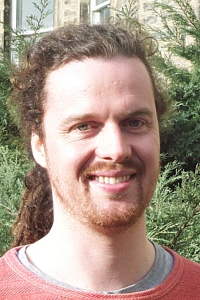 |
Simon King |
| Professor of Speech Processing |
| Linguistics and English Language |
| School of Philosophy, Psychology and Language Sciences |
| University of Edinburgh |
| |
| and director of the |
| |
| Centre for Speech Technology Research |
| |
| Room 3.11, Informatics Forum | |
| 10 Crichton Street | |
| Edinburgh EH8 9AB |
| United Kingdom |
| |
| email:
| | teaching website: speech.zone |
|
|


|
Research
A fundamental question is: What are the basic
building blocks of speech? To answer this question, I am working in a
number of areas.
In
speech recognition, I am looking at new acoustic models,
such as Linear Dynamical Models, factorial-HMMs and other graphical
models that can represent speech not as 'beads on a string' but as
streams of interacting factors. I've investigated ways to automatically find an
inventory of suitable units to model, as well as working on other
alterntives to phonetic units, such as graphemes. One long-standing interest is
the use of phonological/acoustic/articulatory features and
articulatory measurement data as a tool to develop models of
speech.
In speech synthesis, I work on both unit selection methods
and HMM-based speech synthesis. In both of these areas, the
definition of the unit of speech is crucial. Both typically use
context-dependent phonemes or diphones so, in this context, we can
gain some insight into the basic building blocks of speech by asking
"What contextual features must we model?" In unit selection, this
means learning the target cost and in HMM-based speech
synthesis, it relates to the clustering of acoustically similar
units. Neither of these processes is entirely satisfactory, but to
improve them requires a better understanding of how we can construct
speech from basic units.
I am increasingly interested in perceptual measures in speech synthesis,
not just for evaluation of the final output, but within the synthesis
process itself. In unit selection, perceptual measures should be used to determine
equivalent units or contexts, because acoustic similarity and
perceptual interchangeability are not the same thing. In HMM-based
speech synthesis, the training criterion should be perceptual: perhaps
minimum generation error gives us a way to use such a
criterion? How can the requirements of acoustic modelling fit with
this idea of perceptual equivalence?
In both recognition and synthesis, I have recently started work on
multilingual systems as an additional way to look at the basic
units of speech. Is there a univeral set of building blocks for
speech, and can we build systems that use common models or unit
inventories for multiple languages?
- Current research funding
- NST - Natural Speech Technology (EPSRC 2011 - 2016)
- Simple4All - Speech synthesis that improves through adaptive learning (EC FP7 2011 - 2014)
- INSPIRE - Marie Curie Initial Training Network (EC FP7 2012 - )
- Recently completed research grants
- Effective Multilingual Interaction in Mobile Environments - EMIME (EC FP7 March 2008 - Feb 2011)
- Study of Source Features for Speech Synthesis and Speaker Recognition (UKIERI April 2007 - March 2011)
- LISTA - The Listening Talker (EC FP7 2010 - 2013)
Publications
See my publications
page
- Positions I hold
- and positions I have recently held
- Research fellows I currently work with
- PhD students (in chronological order)
- As principal or co-supervisor
- As second supervisor or advisor
- Former students
If you are interested in studying for a PhD at CSTR, you can find more
information here or
here
Travel plans / busy periods
This calendar displays all dates for the next few months when I will be away from the office. Click an
event to get details and location.
Teaching
Office hours
By appointment - you can arrange a time via
Doodle.
Courses
Personal
Why not look at some nice bike rides and walks or you could learn Spanish.


